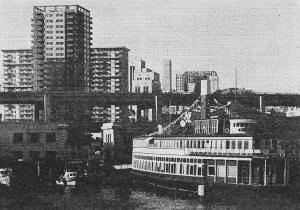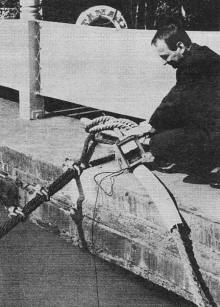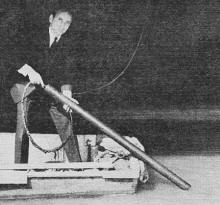|
December 1965 Popular Electronics
 Table of Contents Table of Contents
Wax nostalgic about and learn from the history of early electronics. See articles
from
Popular Electronics,
published October 1954 - April 1985. All copyrights are hereby acknowledged.
|
A news story with a title about
a boat and reverse current is more likely to be referring to water flow in a river or
stream than about electrical current in a conductor. Having
grown up in a neighborhood
next to a tributary of the Chesapeake Bay, I spent quite a bit of time around boats,
both large and small. Salt water is particularly destructive to metal hulls due to
cathodic
corrosion, exacerbated by the salt water's conductivity. While working as an
electrician in the 1970s, I installed electrical supplies for a few dockside cathodic
protection systems that probably functioned like the one described in this 1965 issue
of Popular Electronics magazine. The principle is fairly simple whereby anodes
are placed in the water around the hull and a counter-current is induced to cancel the
natural current flow. Evidently the systems needed to be fine tuned so as to not harm
the hull's paint.
Reverse Current Keeps Ferry Afloat

Converted ferry was stripped of machinery and engines, and connected
to city water, gas, electricity, etc. Problem was to prevent the hull from rusting away
without yearly dry-docking.
By William P. Brothers
When the San Francisco firm of J. Walter Landor ran out of space, it simply bought
one of the last of the Bay ferryboats. The company tied the boat up to a dock and converted
the topside into offices. Keeping the steel hull of the 40-year-old ferry from scuttling
the studios and staff was a problem.

Electrical potential of steel hull is measured every month. Brass
studs brazed to hull give solid electrical contact, accurate reading. Amount of d.c.
current required depends on exposed hull area.
A permanently moored ferryboat is corroded by the electrolytic action of sea water.
One ampere of d.c. will wear away 20 pounds of steel each year. To overcome this action,
designer Alexis Tellis dropped four carbon anodes overside and fed them d.c.-reversed
to the corrosive action of the hull. A solid-state rectifier supplies 0.85-0.95 volt
to the rods. More voltage damages the paint; less voltage corrodes the hull.

Designer Alexis Tellis examines one of four carbon anodes dropped
around steel hull. Anodes, charged with d.c. equal to that ferry would ordinarily lose
by electrolytic action, counteract current flow.
Posted May 22, 2018
|












